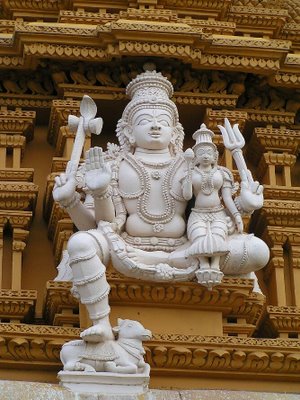Nanjangud -close to Mysore - is famous for its Nanjundeshwara (Shiva) temple. A 1000+ year old temple from the days of Ganga's. And seems to have had major royal patronage all through. It reflects in the grandeur of the temple, exquisite sculpture, two big wooden chariots, and idols of numerous kings & queens.
 This Nanjangud temple is dedicated to Nanjundeshwara or Srikanteshwara, who is Lord Shiva and He is called so as Lord Shiva swallowed the poison which originated while Great Churning of the Ocean. The temple had been under frequent expansion in phases and contributions from different rulers of the region for about 10 centuries by Gangas, Cholas, Hoysalas, Krishnadevaraya, Dalavoys and Wodeyaras from 9th century to 19th century. When Tippu Sultan's Royal elephant had lost its eyesight, he worshiped Lord Nanjundeshwara and had faith in Him. The eyesight of the elephant got recovered and Lord Nanjundeshwara was called as "Hakim Nanjundeshwara" by Tippu Sultan. Tippu Sultan then donated a Shiva Lingam made of jade (precious green stone) along with an emerald necklace to the temple. Hakim means doctor, Lord Nanjundeshwara is also called as "Vaidya Nanjundeshwara" and is even today said to be a healer for his devotees.
This Nanjangud temple is dedicated to Nanjundeshwara or Srikanteshwara, who is Lord Shiva and He is called so as Lord Shiva swallowed the poison which originated while Great Churning of the Ocean. The temple had been under frequent expansion in phases and contributions from different rulers of the region for about 10 centuries by Gangas, Cholas, Hoysalas, Krishnadevaraya, Dalavoys and Wodeyaras from 9th century to 19th century. When Tippu Sultan's Royal elephant had lost its eyesight, he worshiped Lord Nanjundeshwara and had faith in Him. The eyesight of the elephant got recovered and Lord Nanjundeshwara was called as "Hakim Nanjundeshwara" by Tippu Sultan. Tippu Sultan then donated a Shiva Lingam made of jade (precious green stone) along with an emerald necklace to the temple. Hakim means doctor, Lord Nanjundeshwara is also called as "Vaidya Nanjundeshwara" and is even today said to be a healer for his devotees.This temple is situated on right banks of Kapila (Kabini) River and is one of the oldest temples in India. The Shiva Linga in the temple is believed to be installed by the sage Gauthama who had stayed here for some time. This Shiva Linga was also worshiped by Parashurama when he had stayed for some time in this town on his journey to get cleansed from the sin of beheading his mother.
A major event in the pilgrim town is the Rathotsava or the Chariot festival of Nanjundeshwara held twice every year, locally known as Dodda Jathre and Chikka Jathre. Idols of Lord Nanjundeshwara, Goddess Parvathi, Lord Ganapathi, Lord Subramanya and Lord Chandikeshwara are kept in five separate chariots and a traditional puja's are performed to the idols early in the morning on the day of Jathre. After the puja chariots are flagged off. Thousands of devotees pull the Chariots carved in the wood, through the streets of the old city.
Nanjangud Temple Timings:
Morning: 6am to 1pmEvening: 4pm to 8pm.
Temple will be open from
Morning 6am to Evening 8pm
on Special Days and Mondays.



 The image of the Lord Muruga (also spelt as Murugan) is believed to be as "Swayambhu Murti", which lay covered up by an anthill. Chidambara Swamigal is said to have discovered the image of 'Skanda' in the anthill, and then rebuilt the temple and reinstalled the image.
The image of the Lord Muruga (also spelt as Murugan) is believed to be as "Swayambhu Murti", which lay covered up by an anthill. Chidambara Swamigal is said to have discovered the image of 'Skanda' in the anthill, and then rebuilt the temple and reinstalled the image.